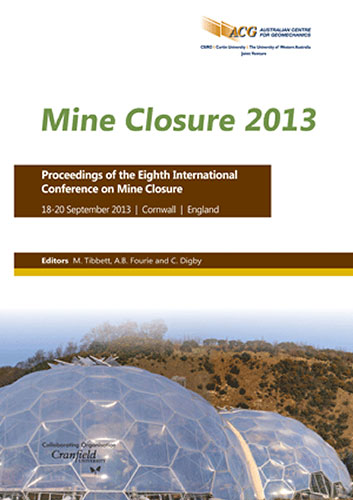The use of ground based LiDAR in rehabilitation performance and landform stability monitoring

|
Authors: Pratt, AS; Mangan, CM |
DOI https://doi.org/10.36487/ACG_rep/1352_32_Pratt
Cite As:
Pratt, AS & Mangan, CM 2013, 'The use of ground based LiDAR in rehabilitation performance and landform stability monitoring', in M Tibbett, AB Fourie & C Digby (eds), Mine Closure 2013: Proceedings of the Eighth International Seminar on Mine Closure, Australian Centre for Geomechanics, Cornwall, pp. 389-402, https://doi.org/10.36487/ACG_rep/1352_32_Pratt
Abstract:
Quantitative assessment of rehabilitation performance is one of the most critical aspects in mine closure and in obtaining sign-off and relinquishment from the relevant regulatory authorities. All current and widely used rehabilitation monitoring techniques require some degree of subjectivity, whether it is in the selection or location of monitoring sites or in the capturing of rehabilitation data. This subjectivity often results in the incorrect measurement or understanding of the specific processes operating in rehabilitation, and it is generally responsible for the continuation of monitoring programmes over a protracted time period and for the discrepancies between monitoring data and actual field observations. Without quantitative and objective data, it is difficult for regulators to approve mine closure and remove the liability on mining companies. This paper will present an alternative rehabilitation monitoring technique that allows for the quantitative measurement of key rehabilitation performance measures, and provides additional landform information that can be used to effectively plan and direct future rehabilitation and mine closure activities. The monitoring technique utilises a ground-based LiDAR (Light Detecting and Ranging) system, which is similar to that often used to assess pit wall stability, to accurately capture quantitative data on floristic parameters (e.g., plant height and growth rates, foliage cover, plant density), surface soil parameters (e.g., percentage of rock and exposed soil cover) and landform attributes (e.g., slope shape, angle and length, berm / setback width). Unlike existing monitoring techniques, whereby these data are captured at specific locations on the post-mine landform, the LiDAR technique can rapidly and accurately measure these parameters over the entire landform, thus removing the subjectivity in selecting sites for monitoring. Post-processing of the LiDAR point cloud enables vegetation growth rates from year to year to be assessed, as well as foliage cover and plant density. A highly accurate Digital Elevation Model (DEM) is created from the point cloud, and terrain analysis can be undertaken to identify areas of concavity (e.g., areas of potential water convergence) and all stages of rilling and gullying. The DEM can be input directly into surface flow and erosion modelling software (e.g., WEPP, SIBERIA), so that long-term surface runoff and sediment yields can be determined. Given the ease of use and rapidity of measurement, the ground-based LiDAR system can also be used to audit all rehabilitation and mine closure earthworks to ensure that it is undertaken to design, and scans of general minesite areas can determine volumes of soil materials that can be directly input into any cost estimator software to accurately determine mine closure costs. This paper will highlight the use of the ground-based LiDAR technique and contrast it to other commonly used rehabilitation monitoring techniques. Case studies will be presented showing the successful application of the LiDAR technique to rehabilitation and mine closure monitoring.
References:
ANZMEC (Australian and New Zealand Minerals and Energy Council) and MCA (Minerals Council of Australia) (2000) Strategic Framework for Mine Closure, National Library of Australian Catalogue Data.
Maptek (2010) Maptek I-Site 8800 Operator Manual, Issue B.
Uren, J. and Price, W.F. (2005) Surveying for Engineers, Palgrave Macmillan, p. 832.
© Copyright 2025, Australian Centre for Geomechanics (ACG), The University of Western Australia. All rights reserved.
View copyright/legal information
Please direct any queries or error reports to repository-acg@uwa.edu.au
View copyright/legal information
Please direct any queries or error reports to repository-acg@uwa.edu.au